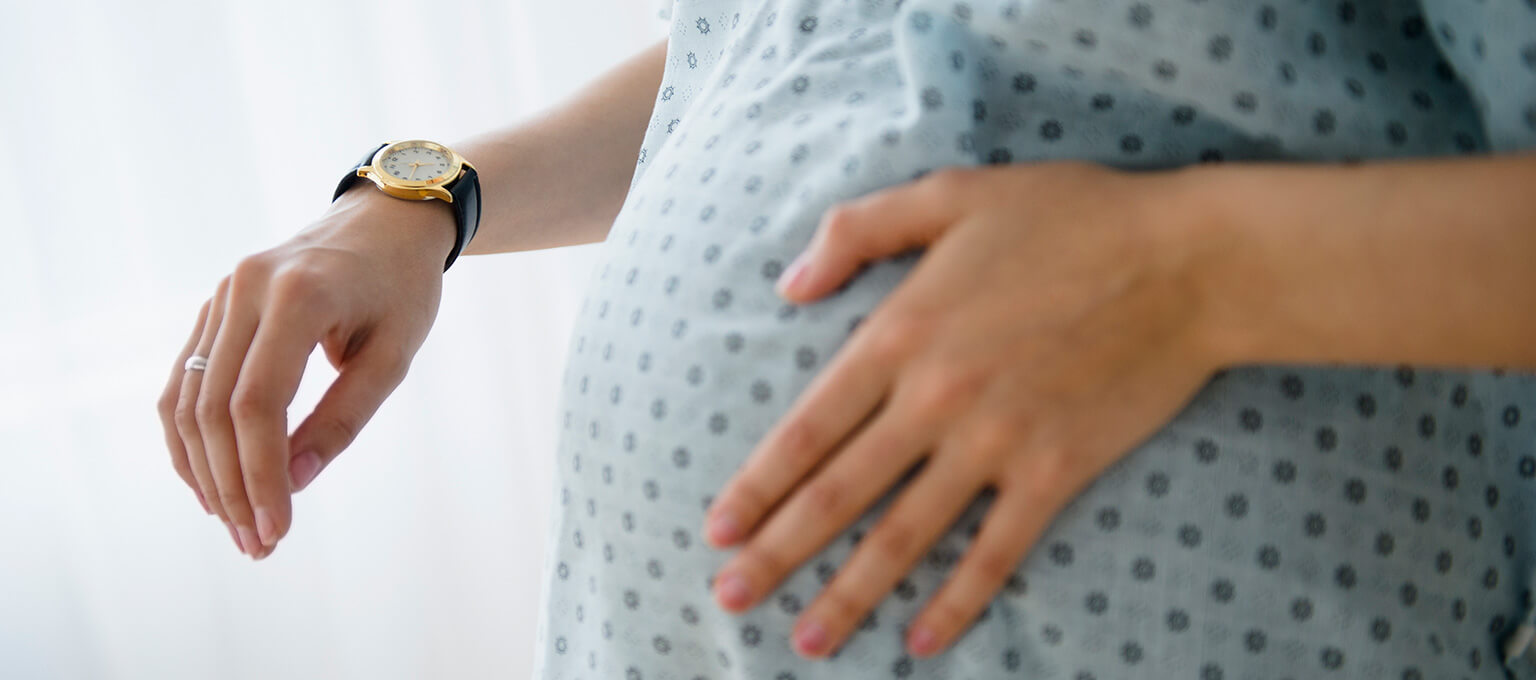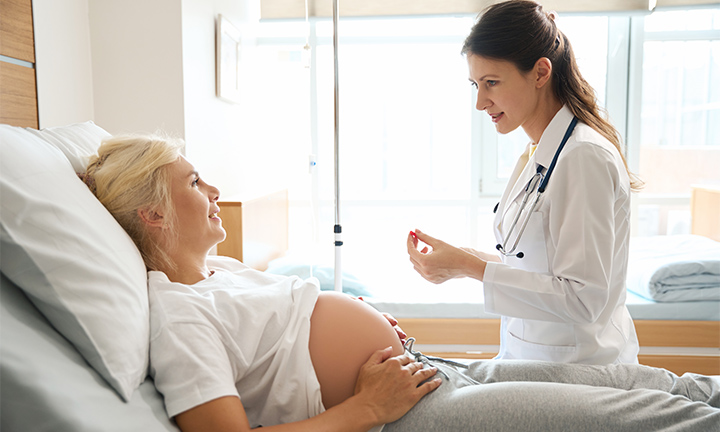
What Are Braxton Hicks Contractions and What Do They Feel Like?
4 min readUpdated February 21, 2024
4 min readUpdated February 21, 2024
Toward the end of your pregnancy, you might start wondering how you’ll know when you’re in labor. It can be especially confusing if you experience contractions in the second or third trimester that are irregular and don’t become more frequent or more intense over time. These are called Braxton Hicks contractions, and they're one of the ways your body gets ready for labor. Keep reading to discover more about Braxton Hicks, including what they feel like, what causes them, when they start, and how to distinguish them from true labor contractions.
What Are Braxton Hicks Contractions?
Braxton Hicks contractions are intermittent, often painless uterine contractions that occur during pregnancy. They’re sometimes referred to as “false” or “practice” contractions, and just like true labor contractions, they’re caused by the muscles of the uterus tightening.
Though Braxton Hicks contractions help your body prepare for birth by tightening and relaxing the muscles of the uterus, they do not actually open the cervix. This will happen when true labor contractions start.
Knowing how long your contractions last and how frequently they occur can help you determine whether you’re experiencing real labor contractions or not. To help keep on top of this, download our guide to tracking your contractions.
What Causes Braxton Hicks Contractions?
As mentioned above, Braxton Hicks contractions are caused by your uterine muscles contracting. This is thought to be your uterus “practicing” for the process of labor.
These contractions are usually harmless and are a normal part of pregnancy. If you have any questions or concerns, though, it's best to consult your healthcare provider.
What Do Braxton Hicks Contractions Feel Like?
Every pregnancy is unique and that includes the symptoms that come with it. So, while not everyone gets Braxton Hicks, some people experience these as mild contractions; others find that Braxton Hicks contractions are painful.
Braxton Hicks contractions are characterized by sensations of tightening and relaxing of the uterus. They are frequently mild (especially in the second trimester) but may also be painful. If you're wondering if Braxton Hicks feel like period (menstrual) cramps, it's helpful to know that these contractions may start out feeling like familiar menstrual cramps but can grow more intense in the final few weeks of pregnancy.
Where Do You Feel Braxton Hicks?
You may experience Braxton Hicks contractions as a tightening sensation primarily in your lower belly and pelvic region or near the top of your uterus.
How Long Do Braxton Hicks Contractions Last?
During pregnancy, it’s natural to have certain questions such as, “Why am I having so many Braxton Hicks contractions?” and “How many Braxton Hicks contractions is normal?”
The duration and timing of Braxton Hicks contractions will vary from person to person, but they typically don't get longer or stronger as they progress, something that sets them apart from true labor contractions. These practice contractions don't follow a consistent pattern and will eventually fade away. It’s also common for Braxton Hicks to stop or ease if you move around or change positions.
If you notice that your contractions are becoming more regular, longer, or more painful, it's a good idea to reach out to your healthcare provider, as these could be signs of true labor. If you’re experiencing a lot of Braxton Hicks contractions or you’re having them all day, this may be due to dehydration or being very active; however, it’s always best to double-check with your healthcare provider.
Further on in our article, we'll provide more details on the differences between Braxton Hicks and true labor contractions.
When Do Braxton Hicks Contractions Start and How Early Can They Start?
Braxton Hicks contractions usually start in the third trimester. If this isn’t your first pregnancy, you might notice them in the second trimester as well.
Braxton Hicks contractions are more likely to strike:
They'll usually pass quickly, but if they become painful or regular, let your healthcare provider know right away.
How to Ease or Stop Braxton Hicks
Luckily, there are a few ways to help ease the discomfort of Braxton Hicks contractions.
It may also help to eat something or to empty your bladder if you’re experiencing Braxton Hicks.
Braxton Hicks vs. True Labor Contractions
A crucial question you may have is what's the difference between Braxton Hicks and true labor contractions? This could be on your mind if you notice contractions before your 37th week of pregnancy and suspect that you’re going into preterm labor. And, if your pregnancy is full term, you might be wondering whether the contraction you’re feeling is another Braxton Hicks or if it’s finally the real deal.
To help figure out whether you’re experiencing Braxton Hicks or labor contractions, familiarize yourself with the signs and symptoms of labor. It also helps to know what Braxton Hicks contractions feel like, and to keep in mind the following differences between Braxton Hicks and true labor contractions:
If you're not sure whether the contractions you're experiencing are Braxton Hicks or true labor contractions, consult your healthcare provider. If you notice any of the following signs of labor, contact your provider right away:
Prodromal Labor vs. Braxton Hicks
There's often some confusion about Braxton Hicks contractions and prodromal labor. Both are considered to be “practice” or “false” contractions and can be experienced before active labor begins; however, there are a few differences between the two.
Braxton Hicks contractions, as we've already discussed, can start as early as the second trimester and are typically irregular and unpredictable; they don't increase in intensity or duration over time. Braxton Hicks contractions do not cause dilation of the cervix.
Prodromal labor, on the other hand, can feel very similar to real labor. These contractions can start several days or weeks before actual labor and can often be confused with the real thing. Unlike Braxton Hicks, prodromal contractions typically have a pattern and may hurt more. However, these contractions don't result in progressive cervical dilation.
In essence, both Braxton Hicks and prodromal labor help the body prepare for childbirth. Still, if you experience any changes or have concerns, consult your healthcare provider.
When to Contact Your Healthcare Provider
While Braxton Hicks contractions are typically harmless and a normal part of pregnancy, it’s natural to wonder when to be concerned about Braxton Hicks and what might warrant a call to your healthcare provider.
It's particularly important to get in touch with your healthcare provider if you experience any of the labor signs mentioned above, such as if the contractions become regular and more frequent, or intensify in pain, or persist even after you've changed activity or hydration levels.
Also, if your Braxton Hicks contractions are accompanied by other symptoms such as lower back pain, pelvic pressure, increased vaginal discharge, and vaginal bleeding, or if you’re less than 37 weeks pregnant and have regular or frequent contractions, you should immediately contact your healthcare provider. These could be signs of preterm labor. Remember, when in doubt, it's always safer to reach out to a healthcare professional who can provide guidance based on your individual circumstances.
FAQS AT A GLANCE
You may be wondering why these contractions are called Braxton Hicks or who they are named after. They take their name from nineteenth century physician John Braxton Hicks, who may have been the first clinician to describe these practice contractions that occur during pregnancy.
The Bottom Line
Braxton Hicks contractions are a normal part of the pregnancy journey, acting as a rehearsal for the big day. Braxton Hicks contractions aren’t generally consistent in frequency and intensity; however, if they become regular, more frequent, or intense, or if accompanied by other concerning symptoms, it's crucial to contact your healthcare provider. Our article all about how to time contractions may be a helpful resource.
Staying hydrated, moving around, or resting and relaxing can help ease any discomfort from Braxton Hicks. Remember, every woman and pregnancy is unique, so listen to your body and consult your healthcare provider if unsure about anything. Understanding your body during this momentous journey will help you navigate it confidently.
Now's a great time to download the Pampers Rewards app to save on future Pampers purchases!
- American College of Obstetricians and Gynecologists, Your Pregnancy and Childbirth: Month to Month, 7th ed. (Washington, DC: American College of Obstetricians and Gynecologists, 2021).
- Mayo Clinic. Guide to a Healthy Pregnancy, 2nd ed. (Rochester, MN: Mayo Clinic Press, 2018).
- Cleveland Clinic. “Braxton Hicks.”
- Cleveland Clinic. “Prodromal Labor.”
- NCBI: Braxton Hicks Contractions
Read more about Pregnancy
Related Articles
Join a World of Support
through Pregnancy and Parenthood.
TRACK WITH TOOLS
LEARN WITH EXPERTS
GET REWARDED














